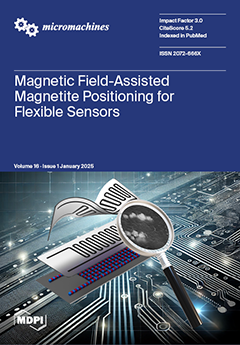The propagation of interface acoustic waves (IAWs) in 128° YX-LiNbO
3/SU-8/overcoat structures was theoretically studied and experimentally investigated for different types of overcoat materials and thicknesses of the SU-8 adhesive layer. Three-dimensional finite element method analysis was performed using Comsol Multiphysics software
[...] Read more.
The propagation of interface acoustic waves (IAWs) in 128° YX-LiNbO
3/SU-8/overcoat structures was theoretically studied and experimentally investigated for different types of overcoat materials and thicknesses of the SU-8 adhesive layer. Three-dimensional finite element method analysis was performed using Comsol Multiphysics software to design an optimized multilayer configuration able to achieve an efficient guiding effect of the IAW at the LiNbO
3/overcoat interface. Numerical analysis results showed the following: (i) an overcoat faster than the piezoelectric half-space ensures that the wave propagation is confined mainly close to the surface of the LiNbO
3, although with minimal scattering in the overcoat; (ii) the presence of the SU-8, in addition to performing the essential function of an adhesive layer, can also promote the trapping of the acoustic energy toward the surface of the piezoelectric substrate; and (iii) the electromechanical coupling efficiency of the IAW is very close to that of the surface acoustic wave (SAW) along the bare LiNbO
3 half-space. The numerical predictions were experimentally assessed for some SU-8 layer thicknesses and overcoat material types. The propagation of the IAWs was experimentally measured in LiNbO
3/SU-8/fused silica, LiNbO
3/SU-8/(001)Si, and LiNbO
3/SU-8/c-Al
2O
3 structures for an SU-8 layer about 15 µm thick; the velocities of the IAWs were found in good agreement with the theoretically calculated values. Although the interest in IAWs was born many years ago for packageless applications, it can currently be renewed if thought for applications in microfluidics. Indeed, the IAWs may represent a valid alternative to standing SAWs, which are strongly attenuated when travelling beneath the walls of polydimethylsiloxane (PDMS) microfluidic channels for continuous flow particle manipulation, provided that the channel is excavated into the overcoating.
Full article






